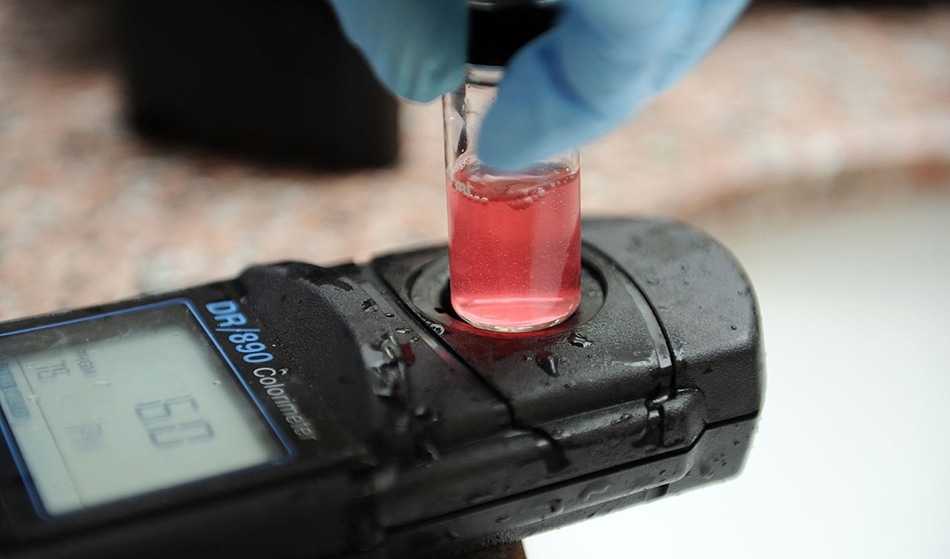
Image Credits: Commons/Wikimedia
Colorimeters are widely used in the sciences to detect the color of a solution and determine its concentration. There have been many uses of colorimeters within the chemical sciences, but given the cross-over between chemistry and nanotechnology, colorimetry is now used for various reasons in nanoscience research
What is Colorimetry?
Colorimetry is the study of colors; namely, studying the color of a chemical solution and using the light absorbance of the solution to determine the concentration of the said solution. This is achieved using colorimeters, by passing various wavelengths of light through a sample and measuring the absorbance at a specific wavelength – i.e., it works on the principle of the Beer-Lambert law.
Colorimeters detect the wavelengths that pass through a sample, making it easy for the instrument software to determine which wavelength(s) have been absorbed. The results are then compared to known standards. It is true that some chemical solutions are colorless. In these circumstances, a reagent that reacts with the solution is often added, as this is the easiest way to create a colored (and measurable) solution.
So how does the absorption relate to concentration? The amount of light absorbed by the solution is proportional to the amount of solute (i.e., the analyte) in solution. So, a higher amount of solute absorbs a greater amount of light; ergo, it has a higher concentration; and vice versa for low amounts of solute. Therefore, the absorption directly relates to solute concentration and can easily be deduced.
How Colorimeters are Used in Nanotechnology
Colorimeters are used across many areas that cross-over into nanotechnology, these include interdisciplinary areas involving the chemical and biological fields. Because colorimetry is an analysis method, it can only offer itself to the nanotechnology industry as an efficient characterization approach. Aside from analyzing concentrations, colorimeters can also determine rates of reaction, the growth of cultures on nanomaterials, sense the presence of specific ions and can provide quality control approaches to laboratories.

Image Credits: science photo/shutterstock.com
Colorimetry has aided in the analysis of many applications that are either a direct part of nanotechnology or employ nanomaterials in some way. Colorimetry has helped to determine the aging effects caused by ultraviolet (UV) rays on polyurethane films. Alongside using other techniques to characterize different properties, the direct use of colorimetry was able to deduce that the methylene groups in certain polyurethane films can become oxidized in a UV/Ozone environment. Colorimetry has also shown the difference between pure films and films coated with antioxidant molecules, with a reduction of aging in the antioxidant films being attributed to suppression in thermal oxidation and photooxidation.
One type of method to synthesize carbon nanomaterials from kerosene employs colorimetry in the quality control stages. The method of note is an electrodischarge processing method using kerosene-based organic liquids. This method requires a special type of calorimeter, known as a photoelectric concentration colorimeter, to examine the main energy characteristics of the organic liquid being processed.
Some nanoparticles, namely gold and silver nanoparticles, also possess properties that lend themselves to be used directly as colorimetric sensors. These nanoparticles are simple sensors, so are not strictly used in colorimeters. However, they can be used for the direct identification of certain ions, such as lead, organo-sulfur compounds, or proteins and small ligands, by invoking a rapid color change in the presence of these species. These nanoparticle colorimetric sensors have found themselves in applications across the biomedical, anti-biofouling and agricultural fields.
Sources and Further Reading
- Seton Hall University: http://pirate.shu.edu/~rawncarr/colorimetry/colorimetry.htm
- AZoSensors: http://www.azosensors.com/article.aspx?ArticleID=324
- University of Michigan: https://encyclopedia.che.engin.umich.edu/
- DCP Microdevelopments: https://www.logitworld.com/
- Sherwood Scientific: https://www.sherwood-scientific.com/
- “Absorbance Measurement by Colorimeter”- Mukesh J. Z. and Shinde A. A., International Journal of Advanced Research in Computer Science and Software Engineering, 2013
- “Chapter 5 – Functional Nucleic Acid-Directed Assembly of Nanomaterials and Their Applications as Colorimetric and Fluorescent Sensors for Trace Contaminants in Water”- Mazumdar D., et al., Nanotechnology Applications for Clean Water (Second Edition)- William Andrew Applied Science Publishers, 2014, DOI: 10.1016/B978-1-4557-3116-9.00005-6
- “Colorimetric detection of controlled assembly and disassembly of aptamers on unmodified gold nanoparticles”- Gopinath S. C. B., et al., Biosensors and Bioelectronics, 2014, 10.1016/j.bios.2013.07.037
- “Comparative analysis of various schemes of electro-discharge processing of kerosene to synthesize carbon nanomaterials”- Kuskova N. I., et al., Surface Engineering and Applied Electrochemistry, 2011, DOI: 10.3103/S106837551
- “Silver based nanomaterial, as a selective colorimetric sensor for visual detection of post-harvest spoilage in onion”- Sachdev D., et al., Sensors and Actuators B: Chemical, 2016, DOI: 10.1016/j.snb.2016.01.049
- “Effects of Additives on Weather-Resistance Properties of Polyurethane Films Exposed to Ultraviolet Radiation and Ozone Atmosphere”- Wang H., et al., Journal of Nanomaterials, 2014, DOI: 10.1155/2014/487343
Disclaimer: The views expressed here are those of the author expressed in their private capacity and do not necessarily represent the views of AZoM.com Limited T/A AZoNetwork the owner and operator of this website. This disclaimer forms part of the Terms and conditions of use of this website.